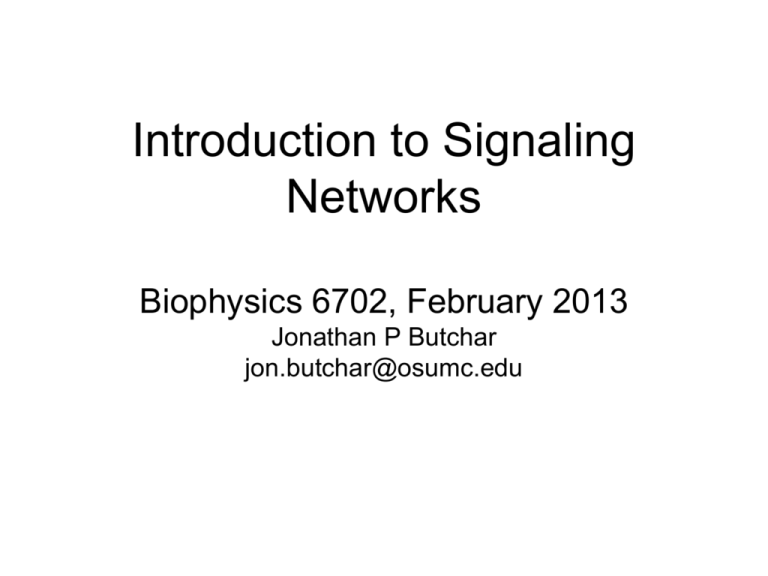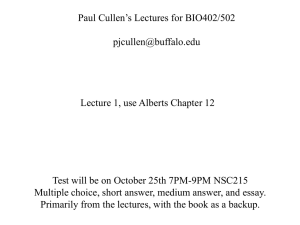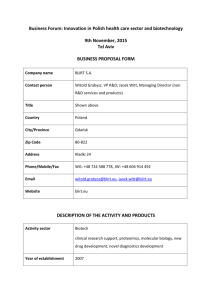FcγR Immune Complex
advertisement

Introduction to Signaling Networks Biophysics 6702, February 2013 Jonathan P Butchar jon.butchar@osumc.edu Outline • General Signaling Concepts • Types of Signaling • Signaling Components – Receptors and Ligands – Downstream Signaling • Adaptor and Effector molecules • Example Signaling Network: FcγR Outline • General Signaling Concepts Different signals and signal combinations lead to different outcomes Figure 15-8 Molecular Biology of the Cell (© Garland Science 2008) A single signal can lead to different outcomes Figure 15-9 Molecular Biology of the Cell (© Garland Science 2008) How? Figure 15-9 Molecular Biology of the Cell (© Garland Science 2008) Strength of signal can determine outcome Figure 15-10 Molecular Biology of the Cell (© Garland Science 2008) How else could a single signal lead to different outcomes? Figure 15-10 Molecular Biology of the Cell (© Garland Science 2008) Slow and fast response times Figure 15-6 Molecular Biology of the Cell (© Garland Science 2008) Different signals can converge on one target Figure 15-20 Molecular Biology of the Cell (© Garland Science 2008) Crosstalk between signaling pathways Figure 15-66 Molecular Biology of the Cell (© Garland Science 2008) Cells can adapt to signaling Figure 15-51 Molecular Biology of the Cell (© Garland Science 2008) How else might cells adapt? Figure 15-51 Molecular Biology of the Cell (© Garland Science 2008) Signals can be amplified Figure 15-28a Molecular Biology of the Cell (© Garland Science 2008) or dampened Figure 15-28c Molecular Biology of the Cell (© Garland Science 2008) Primary and secondary responses Figure 15-15 Molecular Biology of the Cell (© Garland Science 2008) Primary and secondary responses How to tell the difference? Figure 15-15 Molecular Biology of the Cell (© Garland Science 2008) Outline • Types of Signaling Figure 15-4a Molecular Biology of the Cell (© Garland Science 2008) Don’t forget Autocrine signaling Figure 15-4b Molecular Biology of the Cell (© Garland Science 2008) Figure 15-4d Molecular Biology of the Cell (© Garland Science 2008) Figure 15-4c Molecular Biology of the Cell (© Garland Science 2008) Direct Transmission Figure 15-7 Molecular Biology of the Cell (© Garland Science 2008) Outline • Signaling Components – Receptors and Ligands Figure 15-3a Molecular Biology of the Cell (© Garland Science 2008) Figure 15-3b Molecular Biology of the Cell (© Garland Science 2008) Numerous types of ligands • • • • • • • Peptides / Proteins Steroids Nucleotides Fatty Acids Gases Mechanical Forces temperature, etc How do you get from ligand binding to an intracellular response? • Ion fluxes • G-protein activation • Enzyme activation (e.g., Phosphorylation) Na+, K+, Ca2+, ClThere are voltagegated ion channels too e.g., Cystic Fibrosis is caused by defects in a Chloride channel Figure 15-16a Molecular Biology of the Cell (© Garland Science 2008) G-proteins: Guanine nucleotide-binding proteins Figure 15-16b Molecular Biology of the Cell (© Garland Science 2008) Enzyme-containing or enzyme-linked Figure 15-16c Molecular Biology of the Cell (© Garland Science 2008) Example: Receptor Tyrosine Kinases Figure 15-53a Molecular Biology of the Cell (© Garland Science 2008) Inhibition of Receptor Tyrosine Kinases Figure 15-53b Molecular Biology of the Cell (© Garland Science 2008) Inhibition of Receptor Tyrosine Kinases How else could you do this? Figure 15-53b Molecular Biology of the Cell (© Garland Science 2008) Receptors can be locked in an inactive state Figure 15-14b Molecular Biology of the Cell (© Garland Science 2008) …and then unlocked by a ligand Figure 15-14c Molecular Biology of the Cell (© Garland Science 2008) Outline • Downstream Signaling Components – Signaling, Adaptor and Effector molecules Signaling molecules transduce receptor activation Figure 15-54 Molecular Biology of the Cell (© Garland Science 2008) Common domains of signaling molecules Proline-rich Figure 15-22 Molecular Biology of the Cell (© Garland Science 2008) Did I mention this is a really good book? What molecules transmit these signals? • Kinases and Phosphatases • GTP / GDP Kinases and phosphatases e.g., Receptor Tyrosine Kinase: a receptor AND a kinase Figure 15-18a Molecular Biology of the Cell (© Garland Science 2008) Guanosine TriPhosphate and Guanosine DiPhosphate Remember the G-protein coupled receptor Figure 15-18b Molecular Biology of the Cell (© Garland Science 2008) Trimeric G-proteins • 3 subunits – α, β, γ Figure 15-32 Molecular Biology of the Cell (© Garland Science 2008) Monomeric G-proteins • Most well-known is Ras – small GTPase – downstream Raf binds only GTP-Ras, which phosphorylates and hence activates Raf GTPase-activating protein Figure 15-19 Molecular Biology of the Cell (© Garland Science 2008) Guanine nucleotide exchange factor How do all these things get together? Figure 15-21c Molecular Biology of the Cell (© Garland Science 2008) $125.99 at Amazon.com. Scaffolding proteins can aid the interaction of signaling molecules Figure 15-21a Molecular Biology of the Cell (© Garland Science 2008) Binding occurs through characteristic domains • PTB binds phosphotyrosine • SH2 binds phosphotyrosine • SH3 binds prolinerich domains • PH binds phosphoinositides Figure 15-22 Molecular Biology of the Cell (© Garland Science 2008) Proline-rich Signaling molecules can also associate directly with receptors Figure 15-21b Molecular Biology of the Cell (© Garland Science 2008) Example: from G-proteins to gene transcription • • • • Activated receptor Activated G-protein Activated Protein Kinase A The Effector, an activated transcriptional modulator Figure 15-36 Molecular Biology of the Cell (© Garland Science 2008) Lines are blurry at times • Some membrane-bound receptors (e.g., glucocorticoid receptors) can go to the nucleus and regulate gene transcription – Both a receptor and an effector • Phosphorylation can sometimes deactivate rather than activate a protein (e.g., the NF-κB inhibitor IκBα) Outline • Example Signaling Network: FcγR Fcγ Receptors bind the Fc portion of IgG FcγRIIb (CD32b) FcγRIIa (CD32a) FcγRI (CD64) FcγRIIIa (CD16) γ γ γ γ Inhibitory ITAM ITIM Activating ITAM ITAM ITAM ITAM membrane Fcγ Receptors bind the Fc portion of IgG • Rituximab, Herceptin, etc • Autoantibodies (e.g., rheumatoid arthritis) Phagocytosis What kind of signaling is this? http://www.whfreeman.com/immunology/CH01/figure01-04a.gif Immune Complex Y FcγR Sos • FcγR must be clustered • Phosphorylation drives downstream events Y FcγR activation Grb2 Shc -P – ImmunoTyrosine-based Activation Motif Syk • ITIM phosphorylation dampens FcγR activity Btk Ras /MAPK -P Ca2+ flux Src PI3-K PtdIns 3,4,5P 3 Vav Akt NF-κB Phagocytosis Gene Transcription Y Immune Complex Y Downstream signaling: Ras and PI3K Sos FcγR Grb2 Shc -P -P Src PI3-K Syk Btk Ras /MAPK Ca2+ flux PtdIns 3,4,5P 3 Vav Akt NF-κB Phagocytosis Gene Transcription Ras signaling review in under 10 seconds… • G-protein • small GTPase Figure 15-60 Molecular Biology of the Cell (© Garland Science 2008) 2002 edition searchable for free at http://www.ncbi.nlm.nih.gov/books/NBK21054/ Quick PI3K signaling review (phosphoinositide 3-kinase) Requires membrane localization Figure 15-64 Molecular Biology of the Cell (© Garland Science 2008) Y Immune Complex Y There’s crosstalk between Ras and PI3K Sos FcγR Grb2 Shc -P -P Src PI3-K Syk Btk Ras /MAPK Ca2+ flux PtdIns 3,4,5P 3 Vav Akt NF-κB Phagocytosis Gene Transcription Ras src P P P PIP2 PIP3 P 5 5 Shc Sos Grb2 4 PI-3K Syk PLC Erk 4 3 Ca++ Vav Rac Btk Actin Polymerization Phagocytosis / ROS / Cytokine Akt Y Immune Complex Y How could we modulate FcγR activity? Inflammatory Cytokines (IL-1, TNFα etc) Sos FcγR O2- Shc Grb2 -P -P Src Syk Btk PI3-K PtdIns3,4,5P3 Ras /MAPK Ca2+ flux Vav Akt Phagocytosis Gene Transcription Remember, activating and inhibitory receptors FcγRIIb (CD32b) FcγRIIa (CD32a) FcγRI (CD64) FcγRIIIa (CD16) γ γ γ γ Inhibitory ITAM ITIM Activating ITAM ITAM ITAM ITAM membrane Summary • Cells and groups of cells possess mechanisms to generate and respond to signals • Signaling can be autocrine, paracrine, endocrine, synaptic, electrical or mechanical • Receptors sense numerous types of stimuli and begin cascades that lead to cellular responses • Observed responses represent an integration of stimuli, both past and present




